Far Harbor 39
This boat-in-a-box may just change world cruising
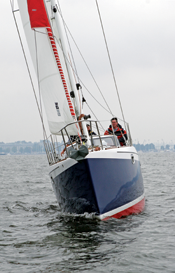 The Far Harbor 39 is a genuinely innovative cruising boat. What intrigues me, however, is the fresh concept that inspired the Far Harbor's unique design. Robert Perry was commissioned by Container Yachts to design the largest boat possible that would easily break down and fit inside a standard shipping container. That begs the obvious question: Why would you want a boat that fits into a big box? Answer: So that you can economically ship it anywhere in the world. If you are still confused, take a look at the company's Web site, www.containeryachts.com. You can't miss the concept on the opening screen. An animated Far Harbor 39 is loaded into a container in Newport, Rhode Island, on June 1, shipped across the Atlantic to Sardinia, Italy, commissioned and sailing again by June 17. Typically the shipping cost is less than $5,000.
The Far Harbor 39 is a genuinely innovative cruising boat. What intrigues me, however, is the fresh concept that inspired the Far Harbor's unique design. Robert Perry was commissioned by Container Yachts to design the largest boat possible that would easily break down and fit inside a standard shipping container. That begs the obvious question: Why would you want a boat that fits into a big box? Answer: So that you can economically ship it anywhere in the world. If you are still confused, take a look at the company's Web site, www.containeryachts.com. You can't miss the concept on the opening screen. An animated Far Harbor 39 is loaded into a container in Newport, Rhode Island, on June 1, shipped across the Atlantic to Sardinia, Italy, commissioned and sailing again by June 17. Typically the shipping cost is less than $5,000. The dimensions of a shipping container dictated the specs of the Far Harbor 39. Standard containers are 40 feet long, 8 feet wide and 8 feet, 6 inches high. The internal measurements are slightly less, hence the Far Harbor 39 has an LOA of just under 39 feet. The narrow beam, all 7 feet, 5 inches of it, is the most striking feature and there's no denying that the boat has a tunnel-like feel belowdecks. But you have to stay with the program, you can't have a super spacious interior in a boat that fits into a container. Engineering the fin keel and rudder to be easily removed solved the shipping height problem. Keeping the mast length under 40 feet was also essential. Bernie Blum of Container Yachts explains that a competent boatyard should be able to put the Far Harbor back together in a day or two. This seems to me to be the key variable in the Far Harbor concept, controlling the cost of decommissioning the boat for shipping and putting it back together again once the container arrives.
The concept is intriguing. It is always more fun to sail your own boat when you're in a faraway place. However, few of us have time to organize and execute long-distance cruising sojourns. The Far Harbor 39 is also a viable alternative to chartering a plain-Jane bareboat that can be rundown, sparsely equipped and less than inspiring to sail. Also, charter boat companies invariably have strict limitations on where and when you can sail. While a typical short-term charter is certainly more cost-efficient than shipping and commissioning your own Far Harbor 39, if you'd like to spend more than a few weeks cruising a new area the Far Harbor concept becomes more interesting. With the Far Harbor 39, you have no restrictions on your sailing range and your cruising schedule can remain flexible. If you shipped your boat to Sardinia, and later wanted to head over to Porto di Roma for a day or two or three, or several weeks, nobody's going to stop you.
The details
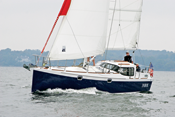 The Far Harbor 39 is built in Zadar, Croatia, in the SAS/Vector yacht facility. SAS was a large-scale builder before the last Balkan War. The Far Harbor project is an impressive example of globalization in the sailing world. The investment, design and principals are American, the tools were made in Slovenia, and production is in Croatia. The OEM parts come from all over the world. Of course, it all makes sense because shipping the boat is an essential part of the equation.
The Far Harbor 39 is built in Zadar, Croatia, in the SAS/Vector yacht facility. SAS was a large-scale builder before the last Balkan War. The Far Harbor project is an impressive example of globalization in the sailing world. The investment, design and principals are American, the tools were made in Slovenia, and production is in Croatia. The OEM parts come from all over the world. Of course, it all makes sense because shipping the boat is an essential part of the equation.
Although we test sailed a wooden prototype, once production ramps up in Zadar the boats will be built in fiberglass. The hull and deck are both cored with PVC foam. High-load areas are solid laminate. Vinylester resins are used exclusively. The 4,500-pound keel is a cold-rolled steel section with a lead bulb. It has a wide top flange with 14 keel bolts designed for easy removal. The wide flange also helps seal the keel to the hull bottom. The rudder shaft and ribs are aluminum, covered with foam and fiberglass. The rudder fits into a rotating tube, so that it is easy to install and remove. In fact, the boat remains watertight even when the rudder is removed. Naturally the engineering concepts coordinate with the special needs to make the boat fit in a box.
John Lee, the director of production for Container Yachts, provided details on how the Far Harbor 39 is loaded, unloaded and reassembled. Once the boat is hauled out of the water, the keel, rudder, rig and saildrive are all removed. The boat is slipped stern first into a container with the help of the Travellift and forklift. The keel is the last piece stowed and the first out on the other end. Once the container arrives in a commercial port it is loaded onto a truck and hauled to a nearby boatyard. The boat is then coaxed out of the container, either by hand or again with a forklift. When it is just about halfway out of the container a Travellift moves into position and one strap is secured. As is slides farther out, the Travellift moves up and the second strap is secured. The boat rides on air cushions in the container. It is then carefully lowered onto the keel. A non-adhesive sealant is used on the keel flange so that it won't leak but can be easily removed. The rudder is also inserted at that point. The sail drive is picked up with a forklift and maneuvered into place. The 40-foot spar is not much of a load to handle and relatively easy to hoist and rig. A competent yard should be able to have the boat up and running in less than 15 hours of billable time according to Lee.
We sailed the prototype Far Harbor 39 on the Chesapeake Bay. It was a gloomy day with light to moderate breezes. When it started to drizzle, we were thankful for the pilothouse. The Far Harbor 39 offers traditional tiller steering in the aft cockpit and wheel steering from inside the pilothouse. The boat needed a little muscle when using the tiller. The cockpit features 6-foot benches and large lockers that also provide good engine access. Visibility from the tiller is adequate at best; however, that's a function of most pilothouse designs. The standard sheet winches are Lewmar 40 ASTs. The boat is set up for easy singlehanded sailing.
The Far Harbor was much livelier than I expected. We clipped along at 5 to 6 knots in 10 to 12 knots of apparent wind. The good turn of speed is a function of a long waterline-the bow is nearly plumb-and a slippery hull shape. Sail area is only 535 square feet but that's plenty of horsepower for most conditions. The boat accelerated smartly and had a nice motion cutting through the typical Chesapeake chop.
On deck
Making your way forward from the cockpit is a bit of a challenge as you climb over tall coamings. The foredeck is nearly flush. I like the clean deck layout. Profurl headsail furling is standard. A Lewmar electric windlass is also standard as is a 44-pound Delta anchor. The 39-foot spar is deck stepped and features swept-back spreaders. Slab reefing is standard on the main and the traveler is mounted on top of the pilothouse.
The pilothouse is cozy and light afforded by large portlights brightens the rest of the interior. The bulkhead-mounted wheel provided good steering control, especially for hydraulic steering, and the visibility, at least looking forward, was excellent. The helm seat is comfortable and offers good support. The engine controls are also in the pilothouse along with a navigation desk and hanging locker. It would be a good idea to add a second set of engine controls in the cockpit.
Down below
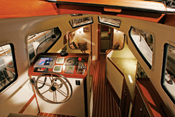 The galley is next in line and includes a three-burner propane stove with oven, 12-volt refrigeration, a large single sink and plenty of counter space. The saloon has port and starboard settees with a fold-away table between. The head is forward to port and, like most of the interior, it is roomier than you'd expect. The V-berth cabin
The galley is next in line and includes a three-burner propane stove with oven, 12-volt refrigeration, a large single sink and plenty of counter space. The saloon has port and starboard settees with a fold-away table between. The head is forward to port and, like most of the interior, it is roomier than you'd expect. The V-berth cabin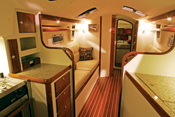 benefits from the plumb bow and flat forward hull sections, and there's plenty of room to stretch out on the 6-foot, 7-inch-long bunks. Finding storage lockers is a challenge in a boat that's just 7 feet, 5 inches wide, but Perry has utilized every nook and cranny. There's a decent-size hanging locker to starboard in the forward cabin. Two overhead hatches and two opening ports in the pilothouse provide ventilation.
benefits from the plumb bow and flat forward hull sections, and there's plenty of room to stretch out on the 6-foot, 7-inch-long bunks. Finding storage lockers is a challenge in a boat that's just 7 feet, 5 inches wide, but Perry has utilized every nook and cranny. There's a decent-size hanging locker to starboard in the forward cabin. Two overhead hatches and two opening ports in the pilothouse provide ventilation.
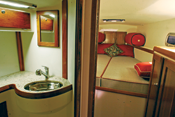 The Far Harbor 39 comes with an impressive standard equipment list. A Raymarine autopilot, chartplotter and radar are standard. Tactick wireless sailing instruments are also part of the standard package. The systems are well thought out. Four AGM Group 31 batteries give the electric system plenty of life, and a 2,000-watt Xantrex inverter is also standard. A fuel-efficient 40-horsepower Yanmar diesel with a saildrive is the standard engine. The boat performed well under power and 75-gallon fuel tanks translates into a 500-mile plus range.
The Far Harbor 39 comes with an impressive standard equipment list. A Raymarine autopilot, chartplotter and radar are standard. Tactick wireless sailing instruments are also part of the standard package. The systems are well thought out. Four AGM Group 31 batteries give the electric system plenty of life, and a 2,000-watt Xantrex inverter is also standard. A fuel-efficient 40-horsepower Yanmar diesel with a saildrive is the standard engine. The boat performed well under power and 75-gallon fuel tanks translates into a 500-mile plus range.
Under sail
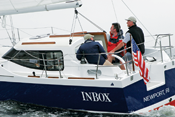 Back on the bay, we put the boat through its paces. Blum was determined to show us what the boat could do. We reached off at 5-plus knots as the winds eased and then beat back to harbor, racing what was left of a dying breeze. Although we were not able to test the boat as thoroughly as we might have liked, some recent sea trials speak to the Far Harbor's performance and seakindliness. The prototype was recently shipped from Ft. Lauderdale to St. Martin, where it was launched and then happily sailed down island to Trinidad. From there, it was decommissioned, stashed in a container and shipped to Holland. It is being commissioned as I write. Clearly the boat-in-a-box concept works, the question is, how many people will buy into this exciting new concept of distance cruising?
Back on the bay, we put the boat through its paces. Blum was determined to show us what the boat could do. We reached off at 5-plus knots as the winds eased and then beat back to harbor, racing what was left of a dying breeze. Although we were not able to test the boat as thoroughly as we might have liked, some recent sea trials speak to the Far Harbor's performance and seakindliness. The prototype was recently shipped from Ft. Lauderdale to St. Martin, where it was launched and then happily sailed down island to Trinidad. From there, it was decommissioned, stashed in a container and shipped to Holland. It is being commissioned as I write. Clearly the boat-in-a-box concept works, the question is, how many people will buy into this exciting new concept of distance cruising?

Comments